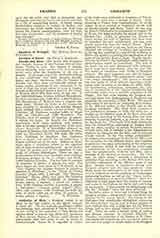

Amadia and Akra. —This double title designates two Catholic dioceses of the Chaldean Rite in Kurdistan, Turkey in Asia. The Diocese of Amadia existed originally under another title; it received its actual name after the foundation of the city of Amadia. In the beginning of the nineteenth century it was subdivided into three dioceses: Amadia, Zakho, and Akra. On June 10, 1895, the Dioceses of Amadia and Akra were provisionally united; the bishop resides sometimes in one, sometimes in the other of these two small towns, or even in Araden. Amadia is the principal garrison town of the vilayet of Mossoul, about fifty miles north of this city. It has 5,000 inhabitants, of whom 2,500 are Mussulmans, Kurds for the most part, 1,900 Jews, 1,600 Chaldeans. The Dominicans of Mossoul have a summer residence there. Within the limits of the diocese the great majority of inhabitants are Kurdish Mussulmans, mingled with a certain number of Jews. The Christians, all Chaldeans, number 6,000, of whom 3,000 are Catholics and 3,000 Nestorians. The Catholics have 14 parishes, 16 churches, 13 priests, 6 schools for boys. In Amadia the Protestant missionaries have many missions with schools. Akra is another principal garrison town of the same vilayet (province). It is beautifully situated on the flank of Chindar, with 4,700 inhabitants, of whom 4,050 are Mussulman Kurds, 300 Jews, 250 Christians, Chaldeans or Jacobites. The Chaldeans have a church and school; the Jacobites have a chapel, hollowed out of the rock. Zebhar, or Zibar, which name is sometimes joined to the episcopal title of Akra, is another garrison post. In the Diocese of Akra the greater part of the population is composed of Kurdish Mussulmans. There are also a small number of Jews, some Jacobites, some Chaldean Nestorians grouped in the 11 villages, and, finally, 1,000 Chaldean Catholics. The last have 13 parishes, 12 churches, 8 priests, 2 schools for boys. The above figures are those given by J. B. Chabot, in his “Etat religieux des dioceses formant le patriarcat chaldeen de Babylone”, in the “Revue de l’Orient Chretien” (Paris, 1896), I, 449-450. The “Missiones Catholic” (Rome, 1895), 612, gives the following figures: Amadia, 2,000 Chaldeans, 15 parishes, 5 secular priests, 5 regulars, 1 school (at Araden); Akra, 2,000 Chaldean families, 8 churches, 6 priests. A. Battandier, “Annuaire pontif. cathol.” (Paris, 1904), 269, indicates 5,000 Chaldeans for both dioceses, of whom 1,000 are for Akra; 17 parishes, 22 secular priests, 4 regulars.
S. PETRIDES

